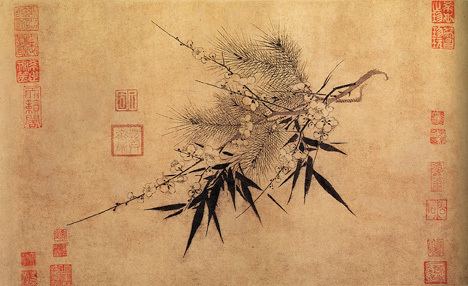Traditional Chinese 歲寒三友 Hanyu Pinyin | Simplified Chinese 岁寒三友 | |
 | ||
The Three Friends of Winter, also known as Suihan Sanyou (or shochikubai), symbolize the pine, bamboo, and plum. The Chinese observed that the pine, bamboo and plum do not wither as the cold days deepen into the winter season unlike many other plants. Known by them as the Three Friends of Winter, they entered the conventions of East Asian culture. Together they symbolize steadfastness, perseverance, and resilience. They are highly regarded in Confucianism and as such represent the scholar-gentleman's ideal.
Contents
History
The Three Friends of Winter are common in works of Chinese art and those cultures influenced by it. The three are first recorded as appearing together in a ninth-century poem by the Tang Dynasty poet Zhu Qingyu (朱慶餘). The Southern Song Dynasty artist Zhao Mengjian (趙孟堅, c.1199-1264), among others of the time, made this grouping popular in painting. The actual term "Three Friends of Winter" can be traced back to the earliest known mention in literature, the Record of the Five-cloud Plum Cottage (五雲梅舍記) from The Clear Mountain Collection (霽山集) by the Song Dynasty writer Lin Jingxi (林景熙, 1242-1310):
"For his residence, earth was piled to form a hill and a hundred plum trees, which along with lofty pines and tall bamboo comprise the friends of winter, were planted."即其居累土為山,種梅百本,與喬松,脩篁為歲寒友。Cultural symbolism
Culturally, the Three Friends of Winter—pine, bamboo, and plum—are grouped together in the context of winter because they all flourish at that season. For this reason they are commonly known as the Three Friends of Winter. They are also referred to simply by their linked names: Song Zhu Mei (松竹梅) in Chinese, transliterated as Sho Chiku Bai in Japanese (literally "pine, bamboo, plum").
In a Korean poem by Kim Yuki (1580-1658), the three friends are brought together in order to underline the paradoxical contrast:
Peach and plum of springtime, don't flaunt your pretty blossoms;Consider rather the old pine and green bamboo at year's end.What can change these noble stems and their flourishing evergreen?In Japan, they are particularly associated with the start of the Lunar New Year, appearing on greeting cards and as a design stamped into seasonal sweets.
